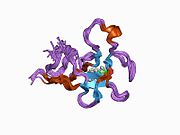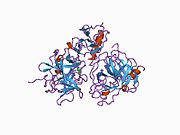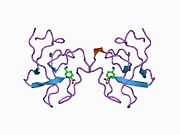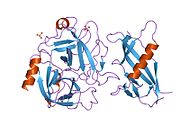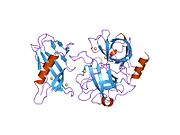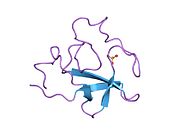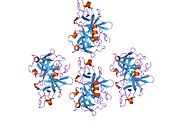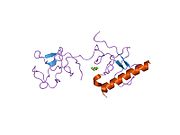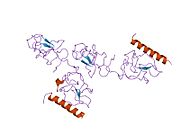Plasmin
Template:PBBPlasmin is an important enzyme (EC 3.4.21.7) present in blood that degrades many blood plasma proteins, most notably, fibrin clots. The degradation of fibrin is termed fibrinolysis. In humans, the plasmin protein is encoded by the PLG gene.[1]
Function
Plasminogen (PLG) is a circulating zymogen that is converted to the active enzyme plasmin by cleavage of the peptide bond between Arg-560 and Val-561, which is mediated by urokinase and tissue plasminogen activator. The main function of plasmin is to dissolve fibrin blood clots. Plasmin, like trypsin, belongs to the family of serine proteases.[1][2][3]
Plasmin is a serine protease that is released as plasminogen from the liver into the circulation and activated by tissue plasminogen activator (tPA), urokinase plasminogen activator (uPA), and factor XII (Hageman factor). Fibrin is a cofactor for plasminogen activation by tissue plasminogen activator. Urokinase plasminogen activator receptor (uPAR) is a cofactor for plasminogen activation by urokinase plasminogen activator. Plasmin is inactivated by alpha 2-antiplasmin, a serine protease inhibitor (serpin).
Apart from fibrinolysis, plasmin proteolyses proteins in various other systems: It activates collagenases, some mediators of the complement system and weakens the wall of the Graafian follicle (leading to ovulation). It cleaves fibrin, fibronectin, thrombospondin, laminin, and von Willebrand factor.
Apart from fibrinolysis, plasminogen is shown to play important role in wound healing, liver repair as well as the maintenance of liver homeostasis.
Plasmin cleavage produces angiostatin.

Pathology
Deficiency in plasmin may lead to thrombosis, as clots are not degraded adequately. Plasminogen deficiency in mice leads to defective wound healing, defective liver repair, reproductive abnormalities.[citation needed]
In human, a rare disorder called plasminogen deficiency type I (OMIM 217090) is caused by mutations of the PLG gene and is often manifested by ligneous conjunctivitis.
Interactions
Plasmin has been shown to interact with Thrombospondin 1,[4][5] Alpha 2-antiplasmin[6][7] and IGFBP3.[8]
References
- ^ a b "Entrez Gene: plasminogen".
- ^ Miyata T, Iwanaga S, Sakata Y, Aoki N (1982). "Plasminogen Tochigi: inactive plasmin resulting from replacement of alanine-600 by threonine in the active site". Proc. Natl. Acad. Sci. U.S.A. 79 (20): 6132–6. doi:10.1073/pnas.79.20.6132. PMC 347073. PMID 6216475.
{{cite journal}}: Unknown parameter|month=ignored (help)CS1 maint: multiple names: authors list (link) - ^ Forsgren M, Råden B, Israelsson M, Larsson K, Hedén LO (1987). "Molecular cloning and characterization of a full-length cDNA clone for human plasminogen". FEBS Lett. 213 (2): 254–60. doi:10.1016/0014-5793(87)81501-6.
{{cite journal}}: Unknown parameter|month=ignored (help)CS1 maint: multiple names: authors list (link) - ^ Silverstein, R L (1984). "Complex formation of platelet thrombospondin with plasminogen. Modulation of activation by tissue activator". J. Clin. Invest. 74 (5). UNITED STATES: 1625–33. doi:10.1172/JCI111578. ISSN 0021-9738. PMID 6438154.
{{cite journal}}: Check date values in:|year=(help); Cite has empty unknown parameters:|laydate=,|laysource=, and|laysummary=(help); Unknown parameter|coauthors=ignored (|author=suggested) (help); Unknown parameter|month=ignored (help); Unknown parameter|quotes=ignored (help)CS1 maint: year (link) - ^ DePoli, P (1989). "Thrombospondin interaction with plasminogen. Evidence for binding to a specific region of the kringle structure of plasminogen". Blood. 73 (4). UNITED STATES: 976–82. ISSN 0006-4971. PMID 2522013.
{{cite journal}}: Check date values in:|year=(help); Cite has empty unknown parameters:|laydate=,|laysource=, and|laysummary=(help); Unknown parameter|coauthors=ignored (|author=suggested) (help); Unknown parameter|month=ignored (help); Unknown parameter|quotes=ignored (help)CS1 maint: year (link) - ^ Wiman, B (1979). "On the mechanism of the reaction between human alpha 2-antiplasmin and plasmin". J. Biol. Chem. 254 (18). UNITED STATES: 9291–7. ISSN 0021-9258. PMID 158022.
{{cite journal}}: Check date values in:|year=(help); Cite has empty unknown parameters:|laydate=,|laysource=, and|laysummary=(help); Unknown parameter|coauthors=ignored (|author=suggested) (help); Unknown parameter|month=ignored (help); Unknown parameter|quotes=ignored (help)CS1 maint: year (link) - ^ Shieh, B H (1987). "The reactive site of human alpha 2-antiplasmin". J. Biol. Chem. 262 (13). UNITED STATES: 6055–9. ISSN 0021-9258. PMID 2437112.
{{cite journal}}: Check date values in:|year=(help); Cite has empty unknown parameters:|laydate=,|laysource=, and|laysummary=(help); Unknown parameter|coauthors=ignored (|author=suggested) (help); Unknown parameter|month=ignored (help); Unknown parameter|quotes=ignored (help)CS1 maint: year (link) - ^ Campbell, P G (1998). "Plasminogen binds the heparin-binding domain of insulin-like growth factor-binding protein-3". Am. J. Physiol. 275 (2 Pt 1). UNITED STATES: E321-31. ISSN 0002-9513. PMID 9688635.
{{cite journal}}: Check date values in:|year=(help); Cite has empty unknown parameters:|laydate=,|laysource=, and|laysummary=(help); Unknown parameter|coauthors=ignored (|author=suggested) (help); Unknown parameter|month=ignored (help); Unknown parameter|quotes=ignored (help)CS1 maint: year (link)
Further reading
- Shanmukhappa K, Mourya R, Sabla GE, Degen JL, Bezerra JA (2005). "Hepatic to pancreatic switch defines a role for hemostatic factors in cellular plasticity in mice". Proc. Natl. Acad. Sci. U.S.A. 102 (29): 10182–7. doi:10.1073/pnas.0501691102. PMC 1177369. PMID 16006527.
{{cite journal}}: Unknown parameter|month=ignored (help)CS1 maint: multiple names: authors list (link)
External links
- Plasmin at the U.S. National Library of Medicine Medical Subject Headings (MeSH)
This article incorporates text from the United States National Library of Medicine, which is in the public domain.

